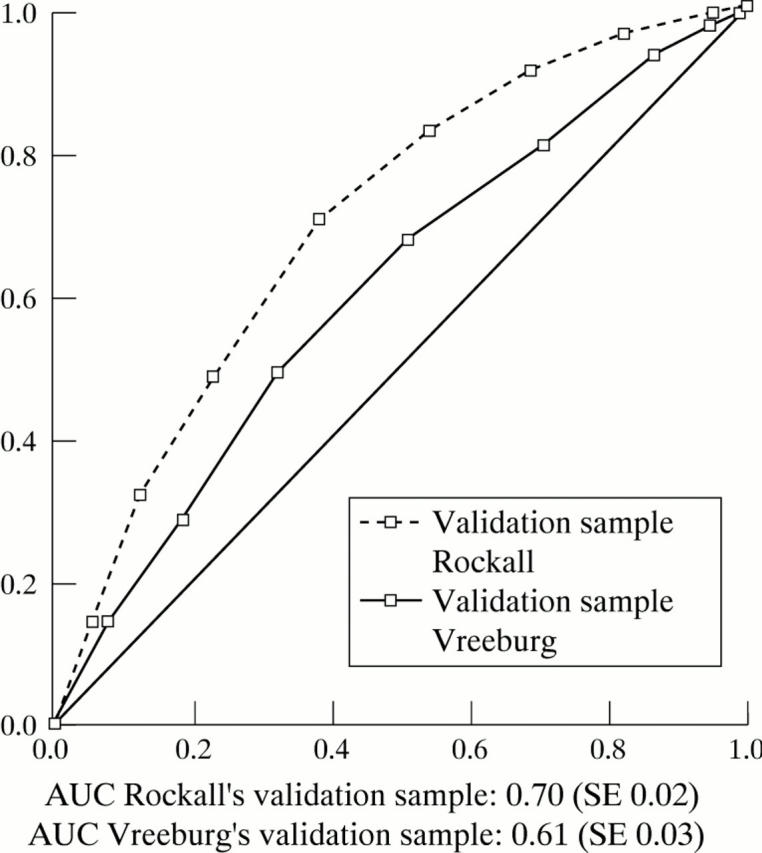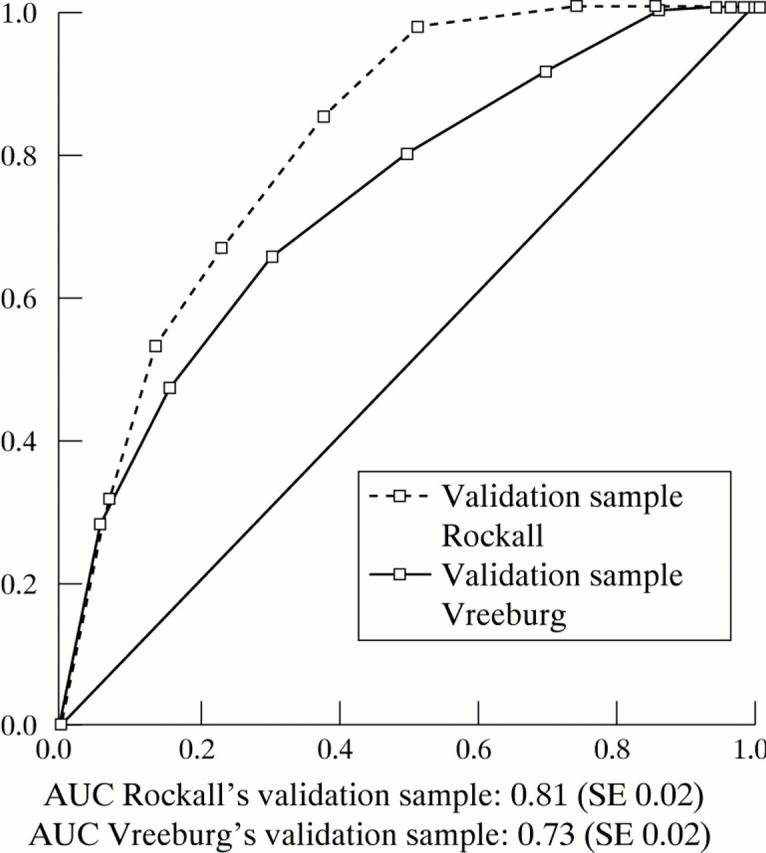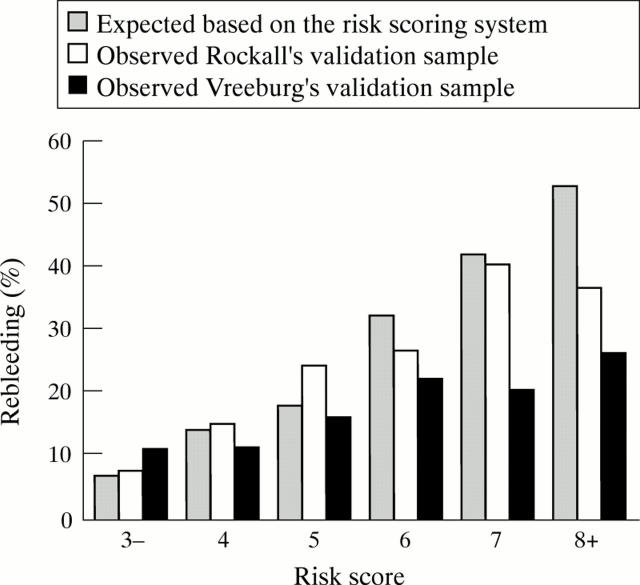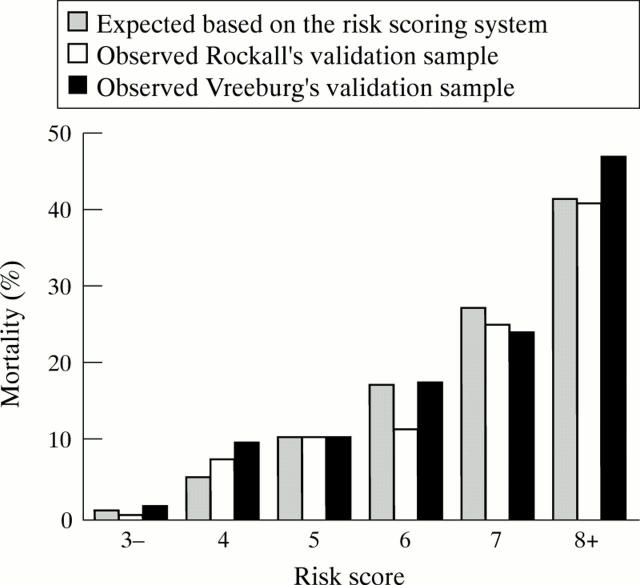Abstract
BACKGROUND—Several scoring systems have been developed to predict the risk of rebleeding or death in patients with upper gastrointestinal bleeding (UGIB). These risk scoring systems have not been validated in a new patient population outside the clinical context of the original study. AIMS—To assess internal and external validity of a simple risk scoring system recently developed by Rockall and coworkers. METHODS—Calibration and discrimination were assessed as measures of validity of the scoring system. Internal validity was assessed using an independent, but similar patient sample studied by Rockall and coworkers, after developing the scoring system (Rockall's validation sample). External validity was assessed using patients admitted to several hospitals in Amsterdam (Vreeburg's validation sample). Calibration was evaluated by a χ2 goodness of fit test, and discrimination was evaluated by calculating the area under the receiver operating characteristic (ROC) curve. RESULTS—Calibration indicated a poor fit in both validation samples for the prediction of rebleeding (p<0.0001, Vreeburg; p=0.007, Rockall), but a better fit for the prediction of mortality in both validation samples (p=0.2, Vreeburg; p=0.3, Rockall). The areas under the ROC curves were rather low in both validation samples for the prediction of rebleeding (0.61, Vreeburg; 0.70,Rockall), but higher for the prediction of mortality (0.73, Vreeburg; 0.81,Rockall). CONCLUSIONS—The risk scoring system developed by Rockall and coworkers is a clinically useful scoring system for stratifying patients with acute UGIB into high and low risk categories for mortality. For the prediction of rebleeding, however, the performance of this scoring system was unsatisfactory.
Keywords: upper gastrointestinal bleeding; risk scoring; prognostic factors; rebleeding; mortality
Full Text
The Full Text of this article is available as a PDF (130.2 KB).
Figure 1 .
Expected versus observed rebleeding by risk score.
Figure 2 .
Expected versus observed mortality by risk score.
Figure 3 .

Discriminative ability of the Rockall scoring system for the prediction of rebleeding, expressed as AUC for the internal validation sample (Rockall) and the external validation sample (Vreeburg).
Figure 4 .

Discriminative ability of the Rockall scoring system for the prediction of mortality, expressed as AUC for the internal validation sample (Rockall) and the external validation sample (Vreeburg).
Selected References
These references are in PubMed. This may not be the complete list of references from this article.
- Bordley D. R., Mushlin A. I., Dolan J. G., Richardson W. S., Barry M., Polio J., Griner P. F. Early clinical signs identify low-risk patients with acute upper gastrointestinal hemorrhage. JAMA. 1985 Jun 14;253(22):3282–3285. [PubMed] [Google Scholar]
- Braitman L. E., Davidoff F. Predicting clinical states in individual patients. Ann Intern Med. 1996 Sep 1;125(5):406–412. doi: 10.7326/0003-4819-125-5-199609010-00008. [DOI] [PubMed] [Google Scholar]
- Branicki F. J., Coleman S. Y., Fok P. J., Pritchett C. J., Fan S. T., Lai E. C., Mok F. P., Cheung W. L., Lau P. W., Tuen H. H. Bleeding peptic ulcer: a prospective evaluation of risk factors for rebleeding and mortality. World J Surg. 1990 Mar-Apr;14(2):262–270. doi: 10.1007/BF01664889. [DOI] [PubMed] [Google Scholar]
- Clason A. E., Macleod D. A., Elton R. A. Clinical factors in the prediction of further haemorrhage or mortality in acute upper gastrointestinal haemorrhage. Br J Surg. 1986 Dec;73(12):985–987. doi: 10.1002/bjs.1800731213. [DOI] [PubMed] [Google Scholar]
- Cook D. J., Guyatt G. H., Salena B. J., Laine L. A. Endoscopic therapy for acute nonvariceal upper gastrointestinal hemorrhage: a meta-analysis. Gastroenterology. 1992 Jan;102(1):139–148. doi: 10.1016/0016-5085(92)91793-4. [DOI] [PubMed] [Google Scholar]
- Greenfield S., Apolone G., McNeil B. J., Cleary P. D. The importance of co-existent disease in the occurrence of postoperative complications and one-year recovery in patients undergoing total hip replacement. Comorbidity and outcomes after hip replacement. Med Care. 1993 Feb;31(2):141–154. doi: 10.1097/00005650-199302000-00005. [DOI] [PubMed] [Google Scholar]
- Hanley J. A., McNeil B. J. The meaning and use of the area under a receiver operating characteristic (ROC) curve. Radiology. 1982 Apr;143(1):29–36. doi: 10.1148/radiology.143.1.7063747. [DOI] [PubMed] [Google Scholar]
- Johnston S. J., Jones P. F., Kyle J., Needham C. D. Epidemiology and course of gastrointestinal haemorrhage in North-east Scotland. Br Med J. 1973 Sep 29;3(5882):655–660. doi: 10.1136/bmj.3.5882.655. [DOI] [PMC free article] [PubMed] [Google Scholar]
- Katschinski B., Logan R., Davies J., Faulkner G., Pearson J., Langman M. Prognostic factors in upper gastrointestinal bleeding. Dig Dis Sci. 1994 Apr;39(4):706–712. doi: 10.1007/BF02087411. [DOI] [PubMed] [Google Scholar]
- La Vecchia C., Lucchini F., Negri E., Reggi V., Levi F. The impact of therapeutic improvements in reducing peptic ulcer mortality in Europe. Int J Epidemiol. 1993 Feb;22(1):96–106. doi: 10.1093/ije/22.1.96. [DOI] [PubMed] [Google Scholar]
- Lemeshow S., Le Gall J. R. Modeling the severity of illness of ICU patients. A systems update. JAMA. 1994 Oct 5;272(13):1049–1055. [PubMed] [Google Scholar]
- Morgan A. G., Clamp S. E. OMGE international upper gastrointestinal bleeding survey, 1978-1986. Scand J Gastroenterol Suppl. 1988;144:51–58. [PubMed] [Google Scholar]
- Morgan A. G., McAdam W. A., Walmsley G. L., Jessop A., Horrocks J. C., de Dombal F. T. Clinical findings, early endoscopy, and multivariate analysis in patients bleeding from the upper gastrointestinal tract. Br Med J. 1977 Jul 23;2(6081):237–240. doi: 10.1136/bmj.2.6081.237. [DOI] [PMC free article] [PubMed] [Google Scholar]
- Pimpl W., Boeckl O., Waclawiczek H. W., Heinerman M. Estimation of the mortality rate of patients with severe gastroduodenal hemorrhage with the aid of a new scoring system. Endoscopy. 1987 May;19(3):101–106. doi: 10.1055/s-2007-1013010. [DOI] [PubMed] [Google Scholar]
- Rockall T. A., Logan R. F., Devlin H. B., Northfield T. C. Risk assessment after acute upper gastrointestinal haemorrhage. Gut. 1996 Mar;38(3):316–321. doi: 10.1136/gut.38.3.316. [DOI] [PMC free article] [PubMed] [Google Scholar]
- Saeed Z. A., Ramirez F. C., Hepps K. S., Cole R. A., Graham D. Y. Prospective validation of the Baylor bleeding score for predicting the likelihood of rebleeding after endoscopic hemostasis of peptic ulcers. Gastrointest Endosc. 1995 Jun;41(6):561–565. doi: 10.1016/s0016-5107(95)70191-5. [DOI] [PubMed] [Google Scholar]
- Saeed Z. A., Winchester C. B., Michaletz P. A., Woods K. L., Graham D. Y. A scoring system to predict rebleeding after endoscopic therapy of nonvariceal upper gastrointestinal hemorrhage, with a comparison of heat probe and ethanol injection. Am J Gastroenterol. 1993 Nov;88(11):1842–1849. [PubMed] [Google Scholar]
- Schein M., Gecelter G. APACHE II score in massive upper gastrointestinal haemorrhage from peptic ulcer: prognostic value and potential clinical applications. Br J Surg. 1989 Jul;76(7):733–736. doi: 10.1002/bjs.1800760729. [DOI] [PubMed] [Google Scholar]
- Schiller K. F., Truelove S. C., Williams D. G. Haematemesis and melaena, with special reference to factors influencing the outcome. Br Med J. 1970 Apr 4;2(5700):7–14. doi: 10.1136/bmj.2.5700.7. [DOI] [PMC free article] [PubMed] [Google Scholar]
- Seggie J., Knottenbelt J. D. Esophageal obstruction by phytobezoar. Rare complication of gastric bezoar. Dig Dis Sci. 1981 Jan;26(1):90–93. doi: 10.1007/BF01307981. [DOI] [PubMed] [Google Scholar]
- Vreeburg E. M., Snel P., de Bruijne J. W., Bartelsman J. F., Rauws E. A., Tytgat G. N. Acute upper gastrointestinal bleeding in the Amsterdam area: incidence, diagnosis, and clinical outcome. Am J Gastroenterol. 1997 Feb;92(2):236–243. [PubMed] [Google Scholar]
- Wara P. Endoscopic management of the bleeding ulcer. A survey. Dan Med Bull. 1986 Feb;33(1):1–11. [PubMed] [Google Scholar]
- Yavorski R. T., Wong R. K., Maydonovitch C., Battin L. S., Furnia A., Amundson D. E. Analysis of 3,294 cases of upper gastrointestinal bleeding in military medical facilities. Am J Gastroenterol. 1995 Apr;90(4):568–573. [PubMed] [Google Scholar]




